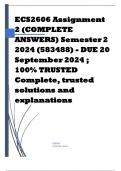ECS2606 Assignment
2 (COMPLETE
ANSWERS) Semester 2
2024 (583488) - DUE 20
September 2024 ;
100% TRUSTED
Complete, trusted
solutions and
explanations.
ADMIN
[COMPANY NAME]
, ECS2606 Assignment 2 (COMPLETE ANSWERS) Semester 2
2024 (583488) - DUE 20 September 2024 ; 100% TRUSTED
Complete, trusted solutions and explanations.
1. Discuss the different incentive-based policies which are
available in environmental economics. [10]
In environmental economics, incentive-based policies are
designed to encourage individuals and businesses to adopt
environmentally friendly practices by aligning their financial
interests with environmental goals. Here are some key types of
incentive-based policies:
1. Pigovian Taxes: Named after economist Arthur Pigou,
Pigovian taxes are levied on activities that generate
negative externalities, such as pollution. The tax is intended
to internalize the external cost of the pollution, making it
more expensive to engage in the harmful activity. For
example, a carbon tax imposes a cost per ton of carbon
dioxide emitted, incentivizing firms to reduce their
emissions or invest in cleaner technologies.
2. Subsidies: Subsidies provide financial support to
encourage environmentally beneficial activities. For
instance, governments might offer subsidies for renewable
energy installations, such as solar panels or wind turbines,
reducing the upfront costs for consumers and businesses.
This policy aims to lower the barrier to adoption and
stimulate growth in green sectors.
3. Cap-and-Trade Systems: Also known as emissions
trading systems, cap-and-trade programs set a maximum
limit (cap) on total emissions for a specific sector or region.
Companies are allocated or can purchase emission permits,




